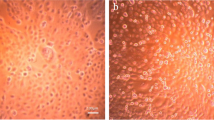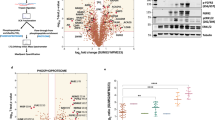Abstract
Although several groups had conducted proteomics of nasopharyngeal carcinoma (NPC), little study was involved in phosphoproteomics, oncogenic signaling, and cancer research about NPC. Analysis of phosphotyrosine proteins from transforming growth factor alpha (TGF-a) triggered phosphotyrosine proteome permitted the identification of novel downstream substrates of the epidermal growth factor receptor (EGFR). Using functional proteomics technology based on 2-DE, 2-D western blotting, and mass spectrometry, we identified and quantified the tyrosine phosphorylation levels of 16 proteins between control and TGF-a-treated CNE2 human NPC cells. Among these proteins, tyrosine phosphorylated levels of ten proteins were increased, and those of six proteins were decreased in TGF-a-treated CNE2 cells compared with control. In addition, among these identified proteins, ANXA3, KRT8, and KRT18 were validated to be novel tyrosine-phosphorylation targets of EGFR signaling by IP-western blotting and part of a complex EGFR phosphotyrosine signaling network. These novel findings will provide new insights into the complex EGFR phosphorylation signaling and may have implications in molecular cancer therapy of NPC.




Similar content being viewed by others
References
Yu MC, Yuan JM. Epidemiology of nasopharyngeal carcinoma. Semin Cancer Biol. 2002;12:421–9.
Cheng AL, Huang WG, Chen ZC, et al. Identification of novel nasopharyngeal carcinoma biomarkers by laser capture microdissection and proteomic analysis. Clin Cancer Res. 2008;14:435–45.
Cheng AL, Huang WG, Chen ZC, et al. Identificating cathepsin D as a biomarker for differentiation and prognosis of nasopharyngeal carcinoma by laser capture microdissection and proteomic analysis. J Proteome Res. 2008;7:2415–26.
Chen Y, Ouyang GL, Yi H, et al. Identification of RKIP as an invasion suppressor protein in nasopharyngeal carcinoma by proteomic analysis. J Proteome Res. 2008;7:5254–62.
Kovarova H, Hajduch M, Livingstone M, et al. Analysis of state specific phosphorylation of proteins by two-dimensional gel electrophoresis approach. J Chromatogr B. 2003;787:53–61.
Kochupurakkal BS, Harari D, Di-Segni A, et al. Epigen, the last ligand of ErbB receptors, reveals intricate relationships between affinity and mitogenicity. J Biol Chem. 2005;280:8503–12.
Saito T, Okada S, Ohshima K, et al. Differential activation of epidermal growth factor (EGF) receptor downstream signaling pathways by betacellulin and EGF. Endocrinology. 2004;145:4232–43.
Charalambous CT, Hannigan A, Tsimbouri P, et al. Latent membrane protein 1-induced EGFR signalling is negatively regulated by TGF alpha prior to neoplasia. Carcinogenesis. 2007;28:1839–48.
Yu Y, Dong W, Zhou X, et al. The significance of serum soluble intercellular adhesion molecule 1 and transforming growth factor alpha in patients with nasopharyngeal carcinoma. Arch Otolaryngol Head Neck Surg. 2004;130:1205–8.
Blagoev B, Ong SE, Kratchmarova I, et al. Temporal analysis of phosphotyrosine-dependent signaling networks by quantitative proteomics. Nat Biotechnol. 2004;22:1139–45.
Chen Y, Tang CE, Ouyang GL, et al. Identification of RKIP as a differentially tyrosine-phosphorylated protein in nasopharyngeal carcinoma and normal nasopharyngeal epithelial tissues by phosphoproteomic approach. Med Oncol. 2009;26:463–70.
Sizhong Z, Xiukung G, Yi Z. Cytogenetic studies on an epithelial cell line derived from poorly differentiated nasopharyngeaal carcinoma. Int J Cancer. 1983;31:587–90.
Nikitin A, Egorov S, Daraselia N, et al. Pathway studio–the analysis and navigation of molecular networks. Bioinformatics. 2003;19:2155–7.
Maguire PB, Wynne KJ, Harney DF, et al. Identification of the phosphotyrosine proteome from thrombin activated platelets. Proteomics. 2002;2:642–8.
Warren CM, Landgraf R. Signaling through ERBB receptors: multiple layers of diversity and control. Cell Signal. 2006;18:923–33.
Grewal T, Enrich C. Annexins—modulators of EGF receptor signalling and trafficking. Cell Signal. 2009;21:847–58.
Izawa I, Inagaki M. Regulatory mechanisms and functions of intermediate filaments: a study using site- and phosphorylation state-specific antibodies. Cancer Sci. 2006;97:167–74.
Li XM, Huang WG, Yi H, et al. Proteomic analysis to identify cytokeratin 18 as a novel biomarker of nasopharyngeal carcinoma. J Cancer Res Clin Oncol. 2009;135:1763–75.
Acknowledgments
This work was supported by a grant from Hibiscus Scholars of Hunan Province, China (2007-362), and National Natural Science Foundation of China (30973290).
Author information
Authors and Affiliations
Corresponding author
Additional information
Lin Ruan and Guo-Liang Wang contributed equally to this work.
Rights and permissions
About this article
Cite this article
Ruan, L., Wang, GL., Chen, Y. et al. Identification of tyrosine phosphoproteins in signaling pathway triggered TGF-a by using functional proteomics technology. Med Oncol 27, 1407–1414 (2010). https://doi.org/10.1007/s12032-009-9394-6
Received:
Accepted:
Published:
Issue Date:
DOI: https://doi.org/10.1007/s12032-009-9394-6




